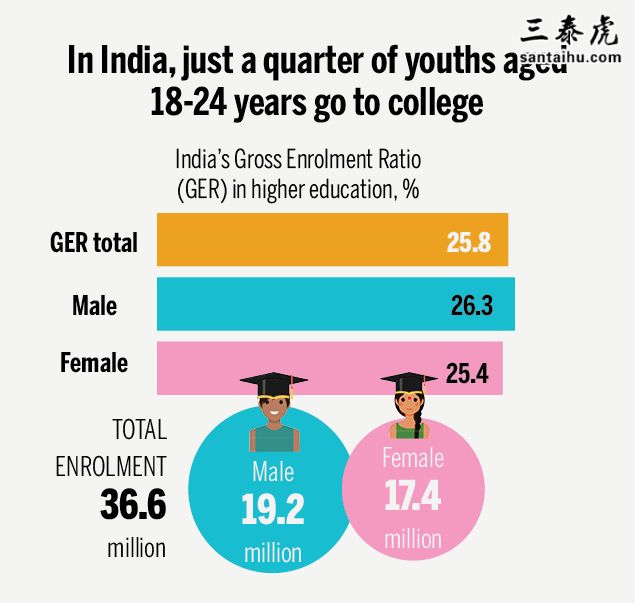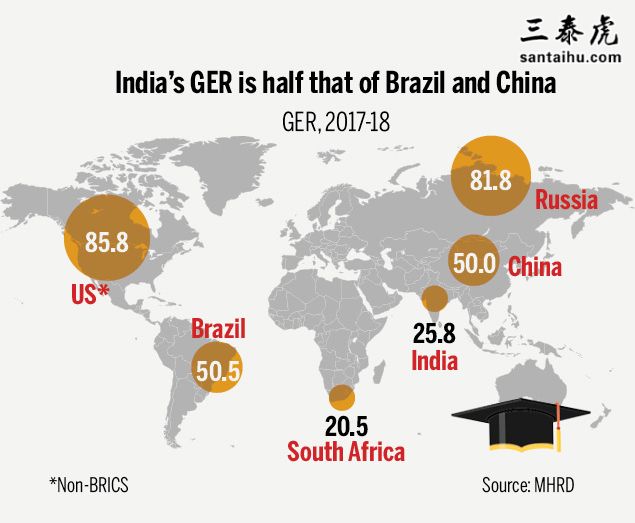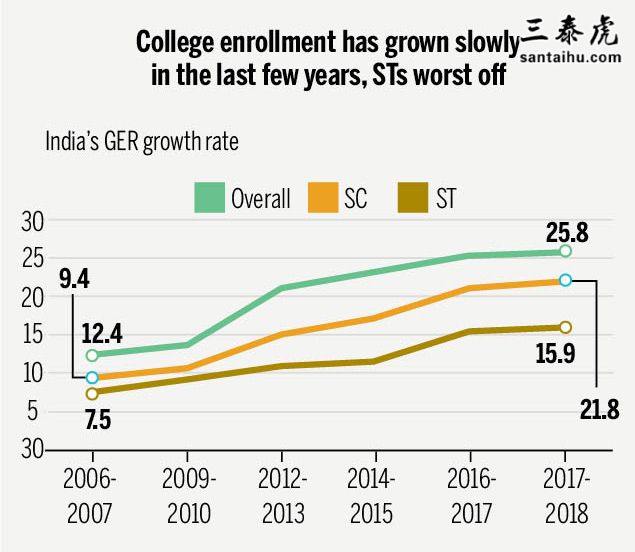Why so few Indians go to college?
为什么上大学的印度人那么少?
MHRD proposes to spend Rs 30k cr over the next 5 years, works on a four-pronged strategy to put backward areas on college education map
印度人力资源与发展部(MHRD)计划在未来5年内投入3000亿卢比,实施“四管齐下”战略,将落后地区纳入大学教育版图。
The government has set itself an ambitious target of raising gross enrolment ratio (GER) in higher education to 40% by 2024 from about 26% at present. The only way it can achieve this is by opening colleges in backward districts and getting those in the socio-economically vulnerable categories to enrol for higher studies. The ministry of human resource development (MHRD) has proposed to invest Rs 30,338 crore to achieve this over the next five years.
印度政府为自己设定了一个雄心勃勃的目标,到2024年将高等教育的总入学率(GER)从目前的26%提高到40%。实现这一目标的唯一途径是在落后地区开设大学,并让那些经济弱势群体进入高等学府。印度人力资源与发展部(MHRD)提议,为了实现这一目标,在未来5年内投资3033.8亿卢比。

In its vision plan for 2019-24, the ministry says it needs to address the “geographically and socially skewed access to higher education institutions in India”. For instance, while the overall GER is 25.8%, for SCs it is 21.8%, and for STs it is even lower at 15.9%. And if you do a global comparison, India fares quite poorly. Just among BRICS nations, India is slightly ahead of South Africa and way behind Russia (81.8%), Brazil (50.5%) and (50.0%).
印度教育部在其2019-2024年远景规划中表示,需要解决“印度高等教育在地区和社会上的不平等”。例如,总入学率为25.8%,表列种姓入学率为21.8%,表列部落入学率则更低,为15.9%。如果做全球比较的话,印度的情况相当糟糕。在金砖国家中,印度入学率略微领先于南非,远远落后于俄罗斯(81.8%)、巴西(50.5%)和(50.0%)。

Enrolment has grown at a slow pace in the last 10-15 years, higher education among STs in particular lagging behind. Identifying the major challenges, the report, ‘Education Quality Upgradation and Inclusion Programme’, states that “empirical evidence points towards the persistence of economic, social, locational, and regional disparities in access to higher education. The higher education system and institutions have to recognise and adapt to meet the demands from diverse communities of students.”
在过去10-15年里,印度入学率增长缓慢,表列部落的高等教育尤其落后。“教育质量提升和包容计划”报告指出了主要挑战,“经验证据表明,在接受高等教育的机会方面,经济、社会、地区和地区之间的差距持续存在。”高等教育体系和机构必须认识到并适应不同学生群体的需求。”

印度时报读者的评论:
译文来源:三泰虎 http://www.santaihu.com/48018.html 译者:Jessica.Wu
外文:https://timesofindia.indiatimes.com
Pandu Prasad•Bangalore•3 hours ago
Wow Govt is going to spend so much on colleges to equip youngsters in knowledge and skill what about culture and social etiquette. When I went to first time 20 years ago they were like us but today they have changed a lot
哇,印度政府要花这么多钱建大学,培养年轻人,让他们获得知识和技能,比如文化和社交礼仪。20年前我第一次去的时候,他们和我们一样,但是如今他们改变了很多。
andi•3 hours ago
yet the educated find it difficult to get descent job
然而,有文化的人发现很难找到一份体面的工作
Boray Sudhindra•Bangalore•3 hours ago
First make AWARE 5RL Edu skills as Duties of Every student!.. then automatically GER rises!
首先要让每个学生都意识到学习技能是自己的责任!
到时候入学率自然会上升!
Kulkarni Pralhad•Bangalore•3 hours ago
Many graduates are toiling in mean jobs. make students approach a problem independently and not to stress on passing examinations
许多大学生从事着卑贱的工作。要让学生学会独立解决问题,而不是搞应试教育
Shanth Kumar•4 hours ago
I still dream of going to college
我做梦都还想上大学呢
Dalbir Singh•4 hours ago
Its only lip service on part of govt as it has raised the college fee to many fold after doing away with UGC. It will further drag the ratio down.
这是政府的空口承诺。废除大学教育资助委员会后,大学学费提高了许多倍,入学率进一步下降。
Attar Singh Panisup•4 hours ago
It is an appreciable approach
值得赞赏
Khualpu Zou•Shillong•4 hours ago
The increase in drop out school children is because of the ever increasing fees and unemployment.
辍学人数的增加,是学费越来越高造成的,是失业率不断提高造成的
Sachin Wazi•4 hours ago
People give more preference to religions thinking that they will solve all our problems
人们更倾向于相信宗教能够解决所有问题
Dharmesh Prajapati•Ahmedabad•4 hours ago
The most general category people are now well earned and having good family wealth or a business, so going college is not bothering them.
有钱人收入丰厚,家财万贯,他们不会因为上大学这事而烦扰。
Ash D•4 hours ago
If youths go to college than who would work for the right extremist groups?
如果年轻人都去上大学了,谁来为极端组织工作?
Ash D•4 hours ago
Remove reservation and population and all our domestic issues will cease to exst
废除预留制,控制人口,所有国内问题都将迎刃而解
Sundaram Thiagarajan•Unknown•5 hours ago
Exorbitant cost is the main reason.Rationalise n standardise the fee structure for the entire country, with uniform syllabus, teaching methods, infrastructure, etc. Or else nationalise all private colleges immediately.
学费过高是主要原因。需要全国统一收费标准,统一教学大纲、教学方法、设备等。。或者马上将所有私立大学国有化。
cbkpb•Mumbai•5 hours ago
When Govt is creating jobs unde
印度政府还忙着创造就业机会
Sasapu rama prasad•6 hours ago
Only one source India will rise the education system .
唯一能改善教育体系的途径就是废除种姓制度。
Krishna Ghosh•Mumbai•6 hours ago
Why even after more than 70 years of independence, still we are discriminating our population on the basis of religion, caste, creed and sex? This sharp tool used by our politicians for wining election.We must bring every poor population of our mother India above poverty level on priority.,Why we are opening only degree colleges or higher educational institutes at remote areas? If we produce huge number of graduates or post graduates, can we give them suitable employment?
为什么在独立70多年后,我们仍然村庄宗教、种姓、信仰和性别歧视?
这些是政客用来赢得选举的利器。我们应先让印度穷人脱贫。
为什么只在偏远地区设立大学或高等教育机构?
培养了大量的毕业生或研究生,我们能给他们提供工作机会吗?
Upnorth•6 hours ago
Government should open vocational colleges. Train poor youth to become welder, plumber, carpenter etc. Otherwise they will get useless BA degrees and go and lube in sounds in large cities for non exstent jobs.
政府应该设立职业学院,培养贫困学生,让他们成为焊工、水管工、木匠等。否则,拿到学位也一无是处,在大城市里找不到工作。
 板球世界杯半决赛,印度队输给新西兰
板球世界杯半决赛,印度队输给新西兰 5名印度大学生轮奸一达利特女同学,
5名印度大学生轮奸一达利特女同学, 报告称印度人在海外存了4900亿美元
报告称印度人在海外存了4900亿美元 2059年,印度人口会达到顶峰
2059年,印度人口会达到顶峰 阿富汗网友如何看印度人
阿富汗网友如何看印度人 阿富汗人如何看印度人
阿富汗人如何看印度人 海外的印度人对离开印度有感到遗憾
海外的印度人对离开印度有感到遗憾